I’ve always been a huge fan of rhythm action games, and even when the genre’s popularity waned, I was still eagerly buying every new Guitar Hero and Rock Band release.
So, when both series made a comeback in 2015, it was a massive event for me. The fact that they both offered distinct experiences made it even more exciting.
However, not everyone shares my level of obsession with this genre. Most gamers probably only want to invest in one of these titles. The big question then becomes: Guitar Hero Live or Rock Band 4 – which one is the better choice?
Having purchased both games at launch and spent considerable time with each, I believe I’m well-positioned to offer an unbiased and detailed comparison to help you decide. Let’s get ready to rock!
Round 1: Backwards Compatibility – Can You Dust Off Your Old Gear?
For newcomers to these series, backwards compatibility might not be a primary concern. However, many gamers still have plastic guitars from previous generations gathering dust. A game that allows you to reuse your existing equipment is definitely a plus.
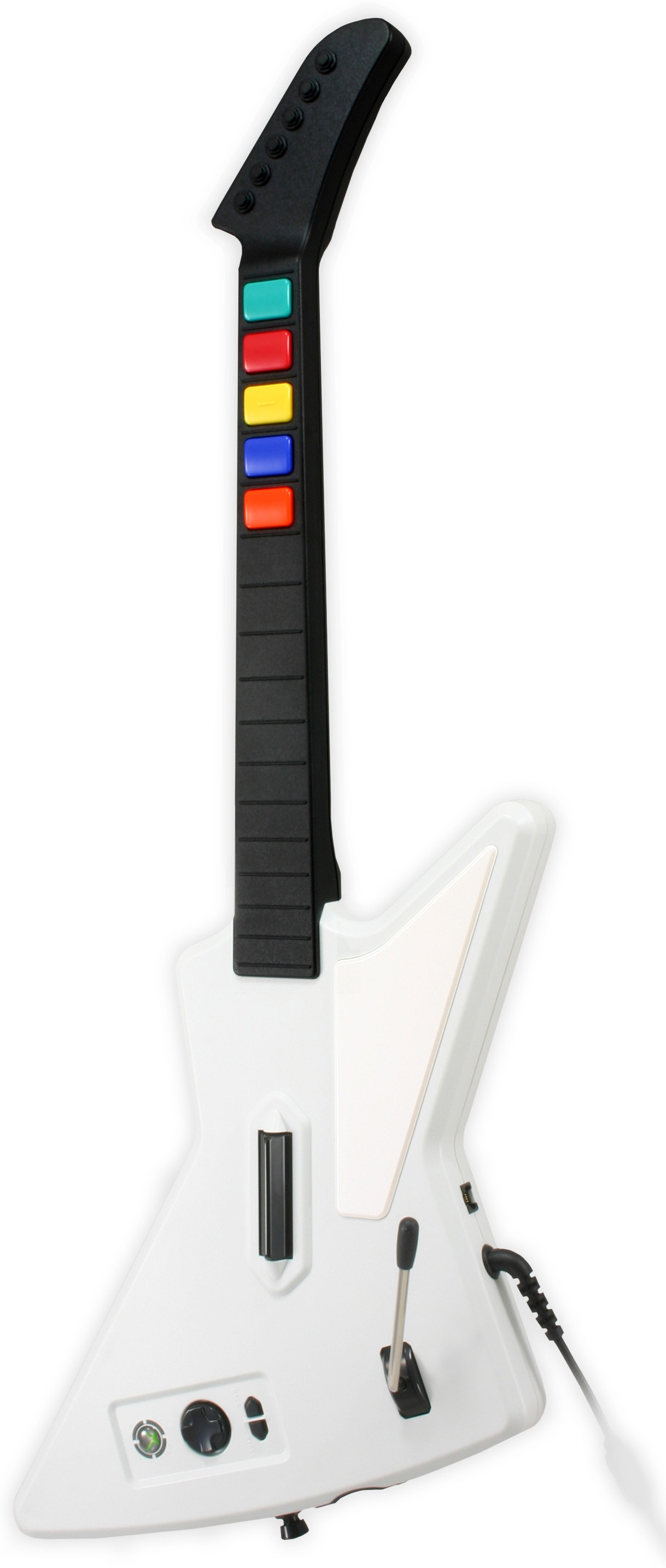 Sleep well, sweet prince of plastic video game instruments
Sleep well, sweet prince of plastic video game instruments
Rock Band 4 proudly boasts backwards compatibility with many older Rock Band and Guitar Hero peripherals, and for the most part, it delivers. My wireless Guitar Hero 3 Xbox 360 guitar worked seamlessly with the Xbox One version of Rock Band 4.
However, it’s not entirely flawless. Due to Microsoft’s device-signing protocols, wired controllers are not compatible. This meant my trusty Guitar Hero II Xplorer – my all-time favorite guitar controller, used for countless hours across Guitar Hero and Rock Band games on Xbox 360 – had to be retired.
This is a specific case, though. Most wireless last-gen controllers should function with Rock Band 4 without any issues.
The same cannot be said for Guitar Hero Live. Its completely redesigned button setup, which we’ll discuss in the next section, renders the classic five-color button system obsolete. Consequently, none of your previous controllers are compatible with Guitar Hero Live.
Winner – Rock Band 4
Round 2: Guitar Gameplay – Revolution or Evolution for Guitar Heroes?
While Rock Band expanded the genre with drums, vocals, and keyboards, guitar remains the core instrument for many fans.
Rock Band 4 maintains the familiar five-color highway system. If you’ve played any previous Rock Band or Guitar Hero games, you’ll feel instantly comfortable.
The gameplay is largely unchanged, with the addition of freestyle solo sections. In these segments, you can play any notes, and the game attempts to create a coherent solo from your improvisations.
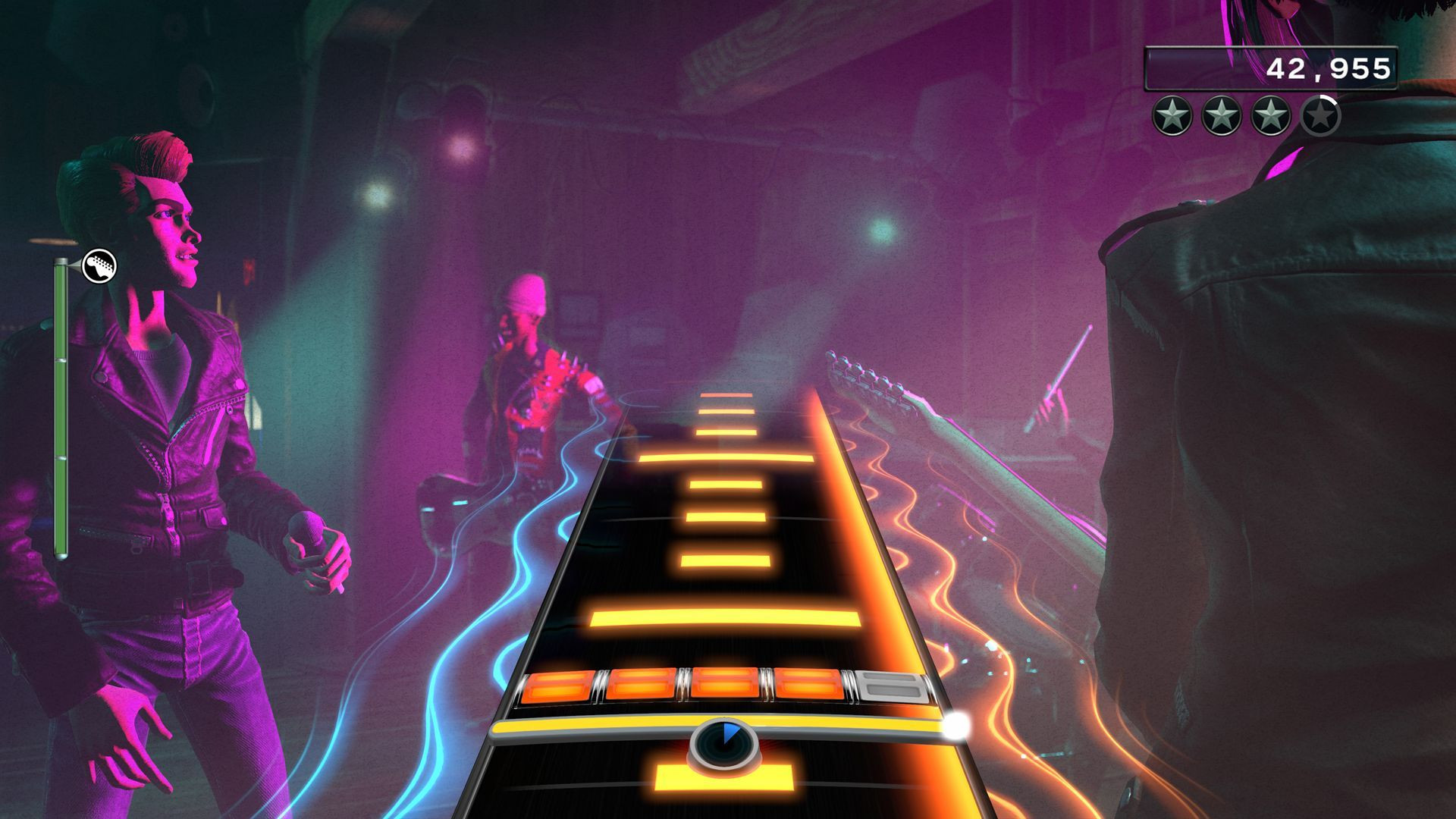 Rock Band 4
Rock Band 4
These freestyle solos seem to be refined versions of similar sections from Harmonix’s Fantasia game on Xbox. Personally, I find them a bit hit-or-miss, often sounding slightly off-key. However, thankfully, there’s an option to disable them.
While Rock Band 4 represents an evolution of the established formula, Guitar Hero Live is a revolution. It abandons the five-color system entirely, introducing a brand-new guitar controller with two rows of three buttons on the neck.
This new setup provides a different feel, arguably more akin to playing a real guitar. On higher difficulty levels, you’ll be playing complex chords spanning both rows, and successfully executing them becomes incredibly satisfying as your muscle memory develops.
This bold redesign was a significant risk, but developer Freestyle Games, known for the innovative DJ Hero, had a proven track record of creating exceptional peripherals from scratch.
After an initial adjustment period of an hour or two, the Guitar Hero Live system proves to be an improvement over the widely accepted five-color standard. In terms of the overall guitar playing experience, Guitar Hero Live takes the round.
Winner – Guitar Hero Live
Round 3: Other Instruments – Band or Solo Act?
This category is decidedly one-sided. The game titles themselves provide a strong hint.
Rock Band 4 remains focused on band gameplay with multiple players. Drums, bass guitar, and vocals are all present and accounted for. Again, most wireless legacy controllers (excluding wired ones) are compatible.
Unfortunately, Rock Band 3 keyboard controllers are not supported in Rock Band 4. Keyboard support, once a promising aspect of the series, was dropped before it truly had a chance to shine.
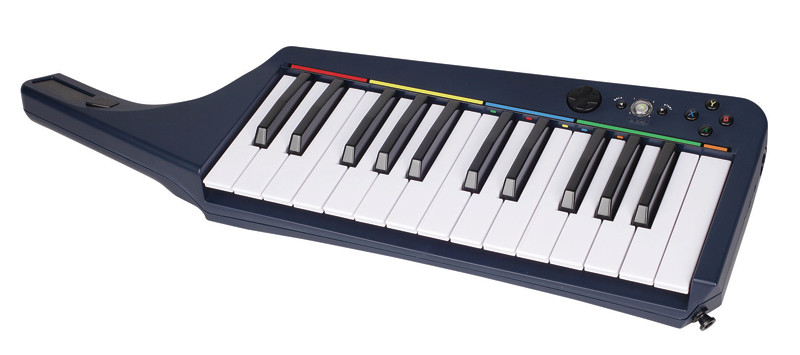 I suppose you can sleep well too, though I
I suppose you can sleep well too, though I
Guitar Hero Live, in contrast, is solely focused on the lead guitar experience. It omits drums and even bass guitar is not playable.
Vocal support is available via a Logitech-compatible microphone or a Guitar Hero Live companion app for iOS. However, the core focus is undeniably mastering the guitar, with other instruments disregarded.
Winner – Rock Band 4
Round 4: Visual Design – Style and Presentation Face-Off
Visual preference is subjective, so opinions may vary.
Rock Band 4 maintains a visual style consistent with previous entries in the series, with only incremental graphical improvements that are not particularly striking.
The overall aesthetic feels familiar to Rock Band veterans. You still create a band and utilize a relatively basic character creator to design the same stylized polygonal avatars you’re accustomed to.
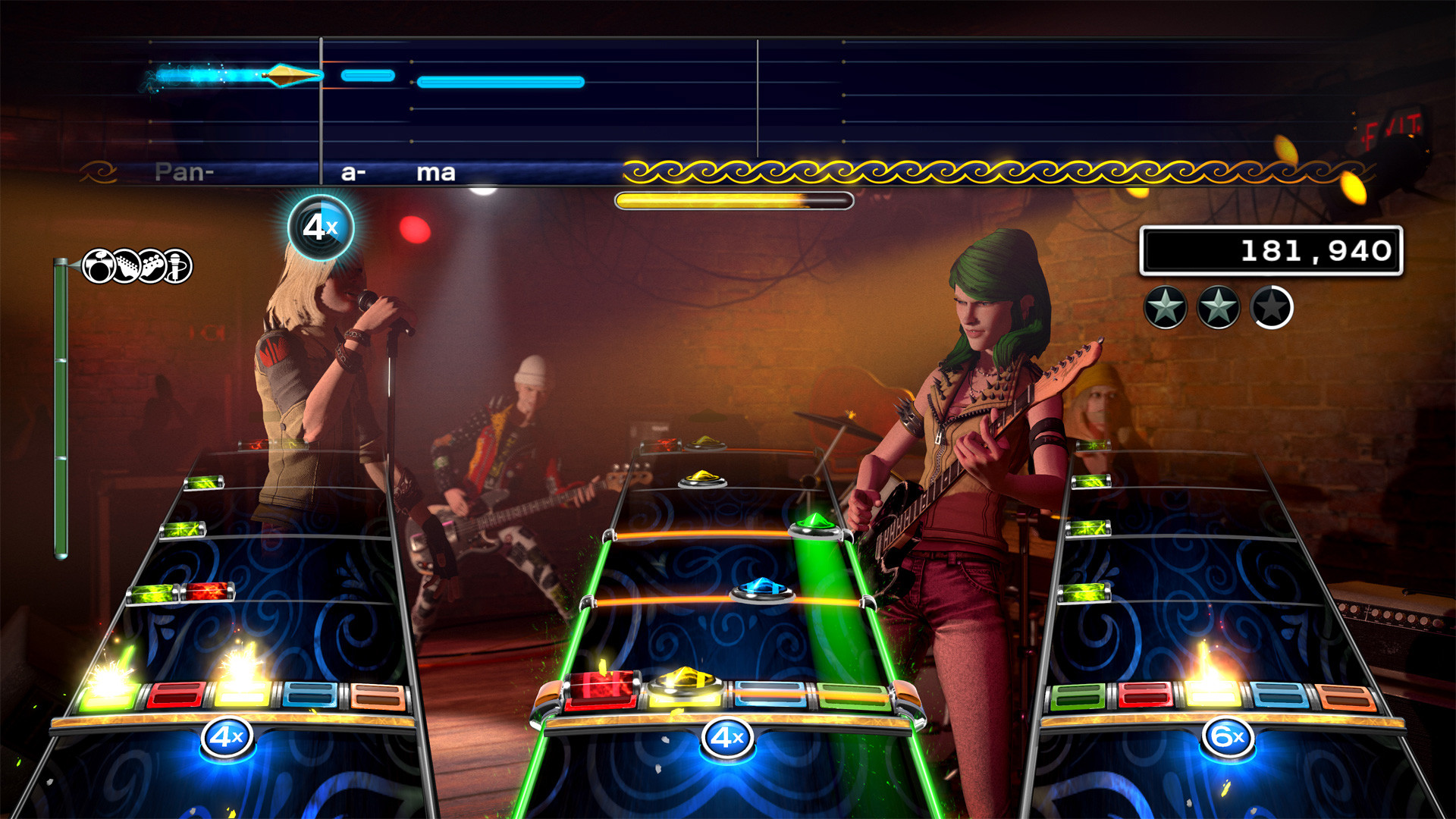 Let
Let
In its defense, the graphics engine is designed to handle a vast library of downloadable content seamlessly. DLC songs integrate well, with character lip-syncing and animations matching the music effectively.
Guitar Hero Live adopts a radically different visual approach, centered around full-motion video clips. This is a double-edged sword, depending on which of the game’s two modes you’re playing.
The video clip approach works well in Guitar Hero TV (GHTV), a streaming music channel within the game. Each song is accompanied by its official music video, providing a great way to discover new artists and songs. Music discovery is a key part of the rhythm game genre’s appeal.
However, the GH Live mode, featuring first-person live gigs with crowd reactions based on your performance, is more divisive.
While well-produced, it’s not as revolutionary as some might suggest. It essentially switches between “good” and “bad” performance videos with somewhat jarring transitions.
More problematically, the acting in GH Live is often cringeworthy, reminiscent of low-budget FMV games. Furthermore, everyone in this mode – bandmates, crowd members – is unrealistically attractive. This aesthetic feels artificial and detracts from the sense of immersion.
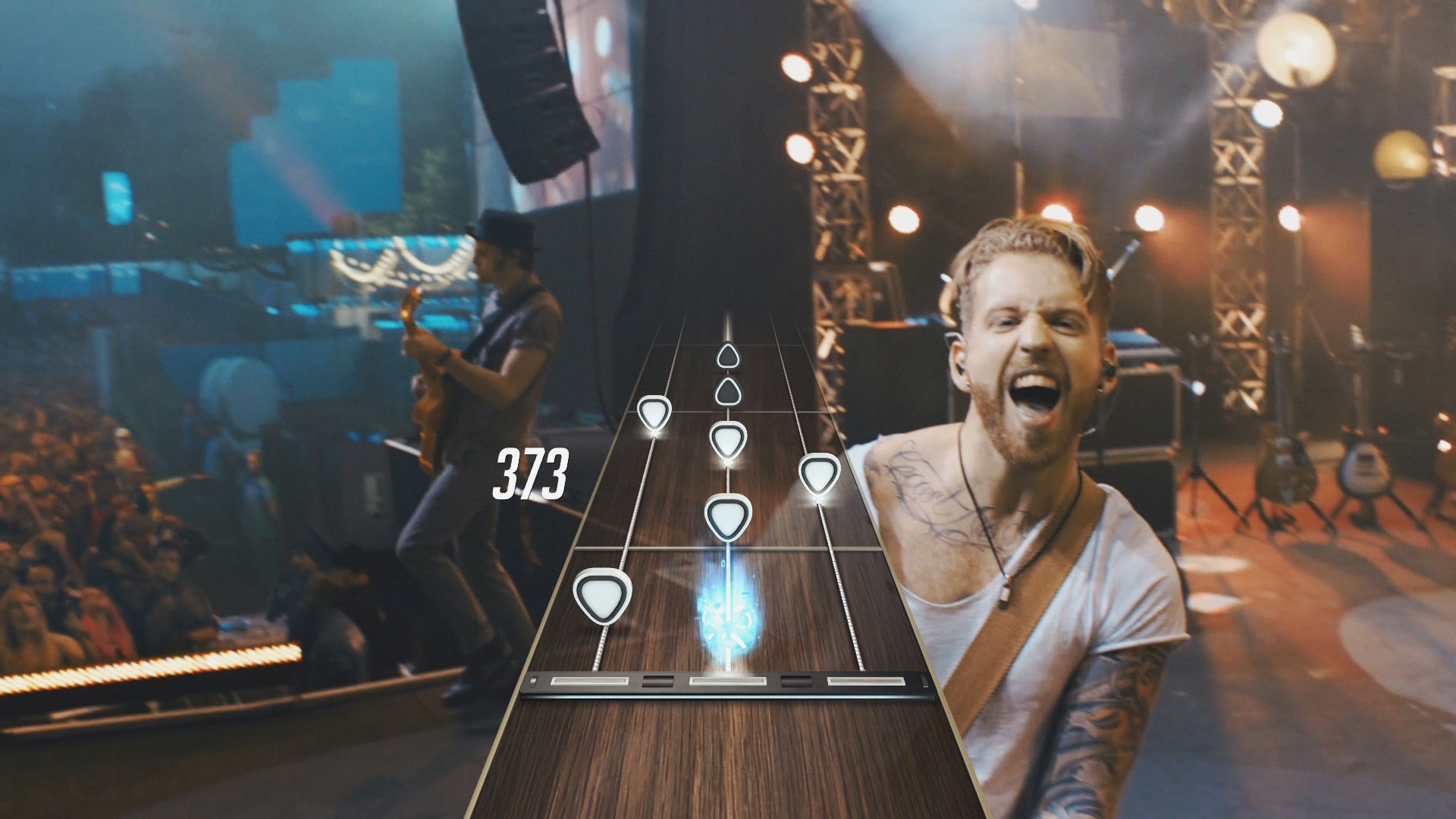 Get off my fucking telly, you complete and utter immaculate moron
Get off my fucking telly, you complete and utter immaculate moron
The hyper-perfect, flawless world of GH Live feels disconnected from reality and undermines the rock band fantasy. However, the GHTV mode’s music video presentation is a significant strength, giving Guitar Hero Live a slight edge in visual design overall, despite the shortcomings of GH Live mode.
Winner – Guitar Hero Live
Round 5: On-Disc and Free Content – Bang for Your Buck Right Out of the Box
For those who prefer not to purchase downloadable content, the amount of content available immediately upon buying the game is crucial.
Rock Band 4 includes 65 on-disc songs, spanning from classic tracks of the 1960s to contemporary hits.
Expanding this library requires purchasing DLC, with the exception of occasional free songs in the online catalog, which are rare. Even importing tracks from Rock Band 3 incurs a fee.
Guitar Hero Live‘s GH Live concert mode features 42 songs, ranging from 1966 to more recent tracks.
However, the GHTV mode launched with over 200 music videos available for streaming and play at no extra cost. Since launch, hundreds more songs have been added, providing a continuous stream of new, free content.
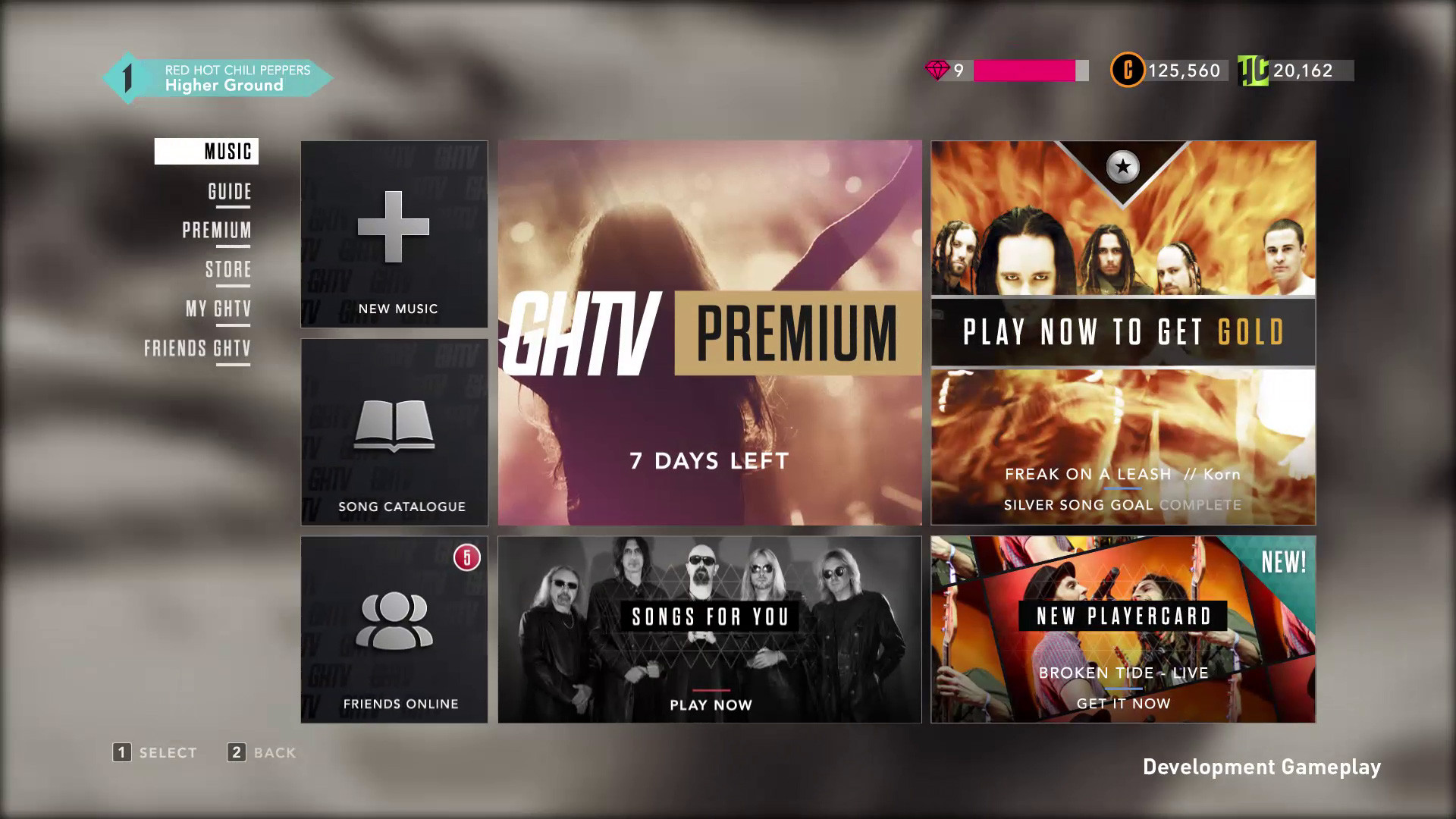 The GHTV mode in all its glory. This is Guitar Hero Live
The GHTV mode in all its glory. This is Guitar Hero Live
While GHTV’s streaming nature means you don’t have on-demand access to every song at any time, you can use play tokens to play specific songs whenever you want. These tokens can be purchased with real money or, importantly, earned through in-game currency gained by playing GHTV’s streaming channels.
Given the vast and growing library of free, randomly accessible content, Guitar Hero Live offers significantly more content for the initial purchase price compared to Rock Band 4.
Winner – Guitar Hero Live
Round 6: Downloadable Content – Building Your Music Library
For players willing to invest in downloadable content to expand their song library, the landscape shifts.
Guitar Hero Live becomes less appealing in this scenario. While GHTV boasts a large library, you never truly own these songs. Playing specific songs requires tokens, which need to be replenished.
This token system means that repeatedly playing a favorite song becomes restricted. Once tokens are depleted, further play requires spending more money.
Furthermore, due to the full-motion video nature of GH Live mode, adding new DLC songs to that section is prohibitively expensive. Consequently, no additional paid songs are expected for GH Live beyond the initial 42 on-disc tracks.
Rock Band 4 takes a different approach. Its engine is designed for easy integration of new songs, and it has embraced DLC extensively.
A vast majority of the Rock Band 3 DLC catalog has been ported to Rock Band 4, offering access to well over 1500 songs for purchase.
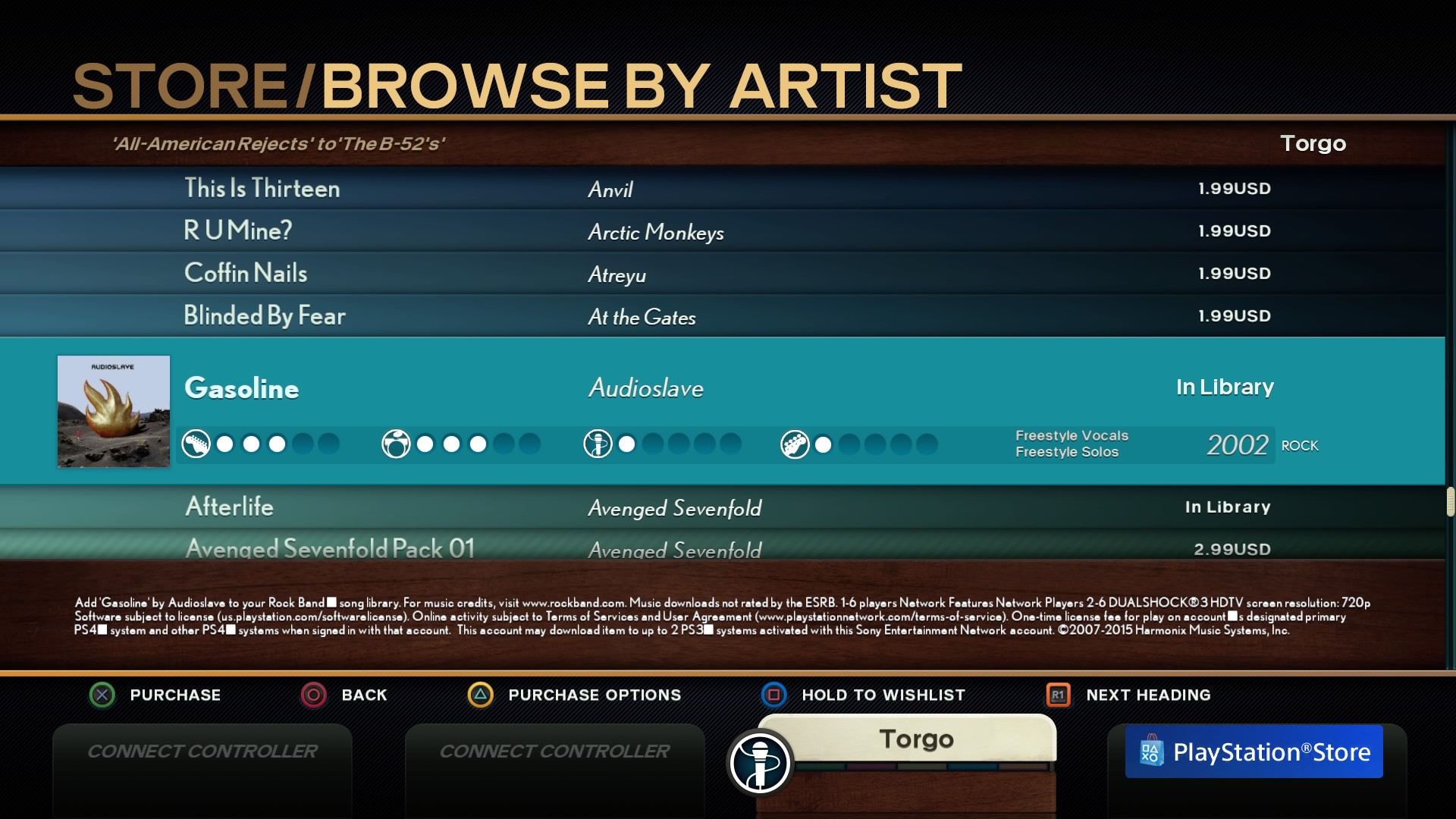 You can even buy Audioslave stuff if you want to pretend it
You can even buy Audioslave stuff if you want to pretend it
Crucially, purchasing a song in Rock Band 4 grants permanent ownership and unlimited play.
For players with a budget for regular DLC purchases, Rock Band 4 is the superior choice for building a comprehensive music library.
Winner – Rock Band 4
Round 7: Single-Player Experience – Going Solo on Stage
Rhythm games offer different experiences depending on whether you’re playing alone or with others. How do these titles cater to solo gamers?
Guitar Hero Live, with its lead guitar focus, first-person perspective, and omission of other instruments, is clearly designed with single-player gameplay in mind.
 You
You
This is most evident in GHTV mode, where you create a profile and earn experience points. Playing songs and gaining experience levels you up and unlocks rewards like song highway styles and profile icons.
Each song in GHTV also has specific challenges, adding replayability.
Rock Band 4 is less generous to solo players. Its Career mode is surprisingly short compared to Rock Band 3. After completing it, the main options are replaying the career or playing individual songs in Quick Play mode.
For a single-player experience with a sense of progression and reward, Guitar Hero Live offers a more compelling solo journey.
Winner – Guitar Hero Live
Round 8: Local Multiplayer – Jamming with Friends
While solo play is enjoyable, the plastic instrument genre truly shines in local multiplayer with friends and family.
In this aspect, Guitar Hero Live falls significantly short. It barely supports local multiplayer at all. Only GHTV mode recognizes a second guitar, and even then, both players play the same instrument part.
This results in competition rather than cooperation. Players simply compete for the highest score, which is often unbalanced and less fun when skill levels differ greatly.
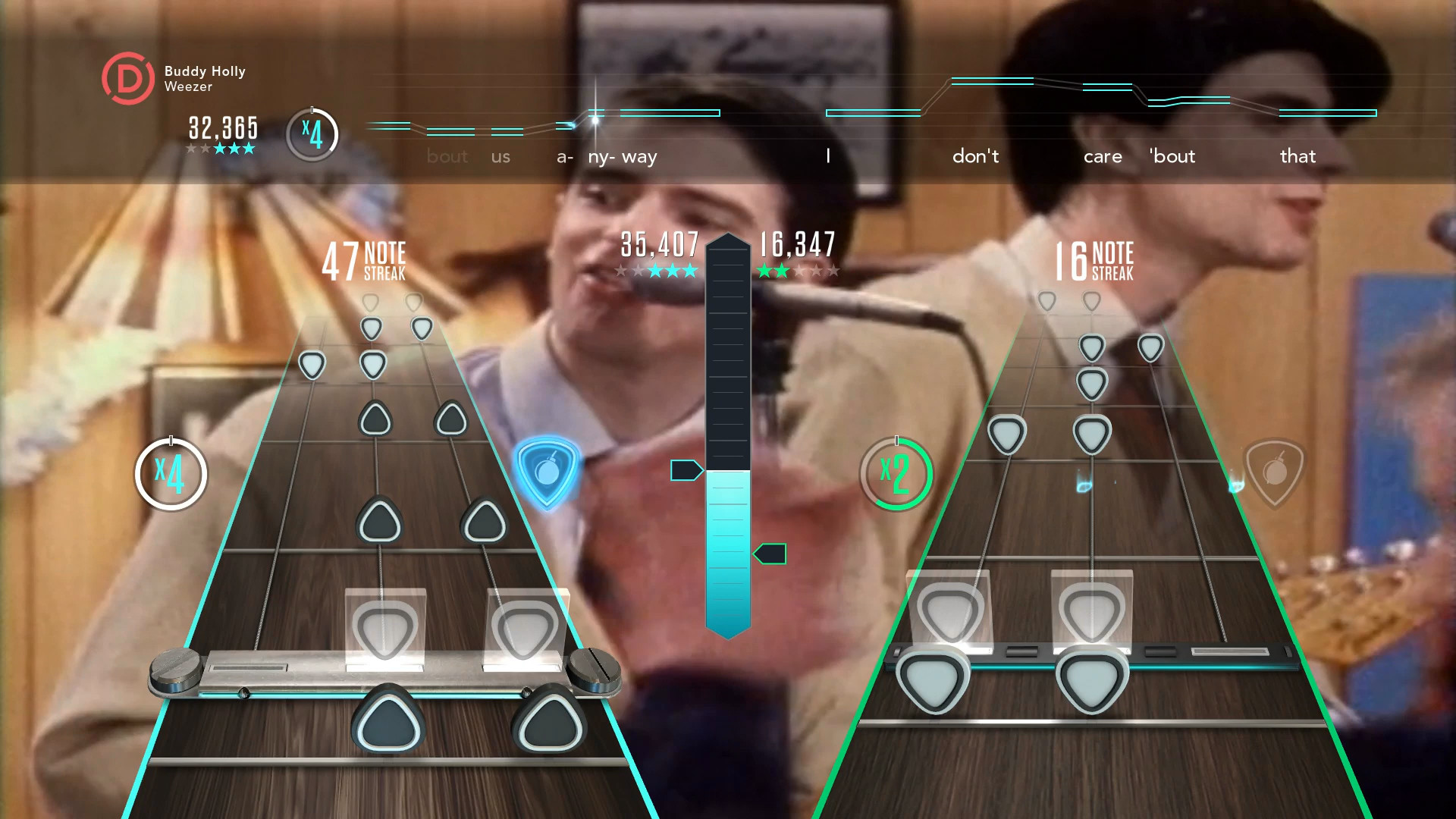 Not even Weezer can make local multiplayer better in Guitar Hero Live
Not even Weezer can make local multiplayer better in Guitar Hero Live
As mentioned, Guitar Hero Live prioritizes single-player. Rock Band 4, however, is built for multiplayer.
While it doesn’t revolutionize local multiplayer, the core experience of four players rocking out together on guitar, bass, drums, and vocals remains incredibly enjoyable. Building up multipliers and nailing song sections as a band is still a fantastic social gaming experience.
Rock Band was a multiplayer highlight of the previous generation, and Harmonix wisely maintained and refined this strength in Rock Band 4.
If local multiplayer is a priority, Rock Band 4 is the clear winner.
Winner – Rock Band 4
Round 9: Ongoing Updates – Long-Term Support and Evolution
Both Harmonix and Activision have indicated that Rock Band 4 and Guitar Hero Live are intended as platforms that will be continuously updated, rather than followed by annual sequels.
Within months of release, both games demonstrated this commitment. Rock Band 4 received a significant update adding social score challenge features, character customization options, and a challenging Brutal mode.
Guitar Hero Live has also delivered updates, adding a steady stream of new songs to GHTV and new customization options like themed note highways. It also introduced an online multiplayer mode where players are matched against similarly skilled opponents in GHTV for score-based competition.
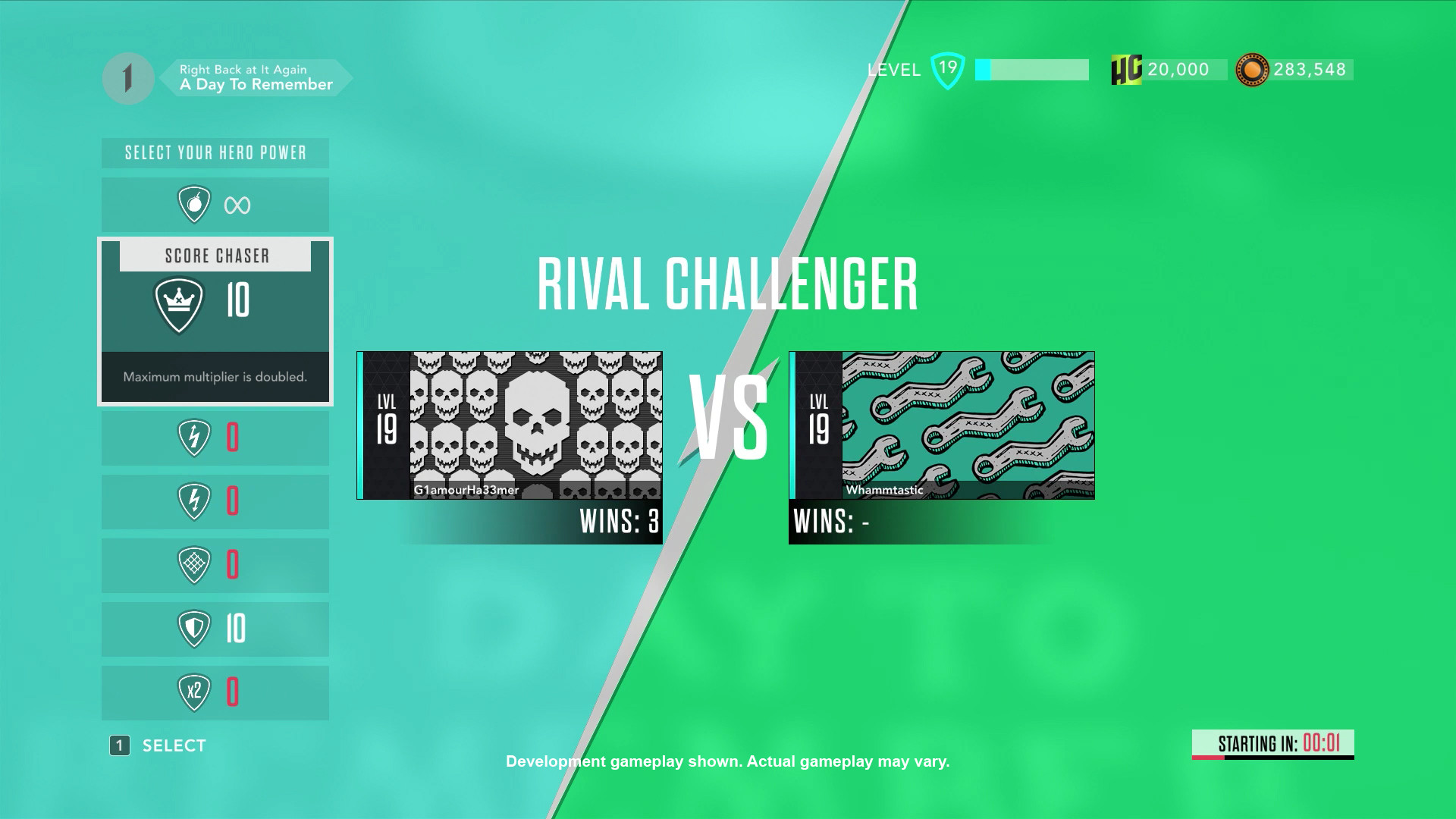 Guitar Hero Live Rivals mode
Guitar Hero Live Rivals mode
Both games are committed to ongoing support and updates, including new songs, customization, and gameplay features. Regardless of which game you choose, both are likely to improve and evolve over time.
Winner – Draw
The Verdict: Guitar Hero Live or Rock Band 4 – Which Game Rocks Harder?
After this extensive comparison, the ultimate recommendation depends on your playing style and preferences.
If you’re primarily a single-player gamer and don’t anticipate frequent local multiplayer sessions, Guitar Hero Live is the stronger choice.
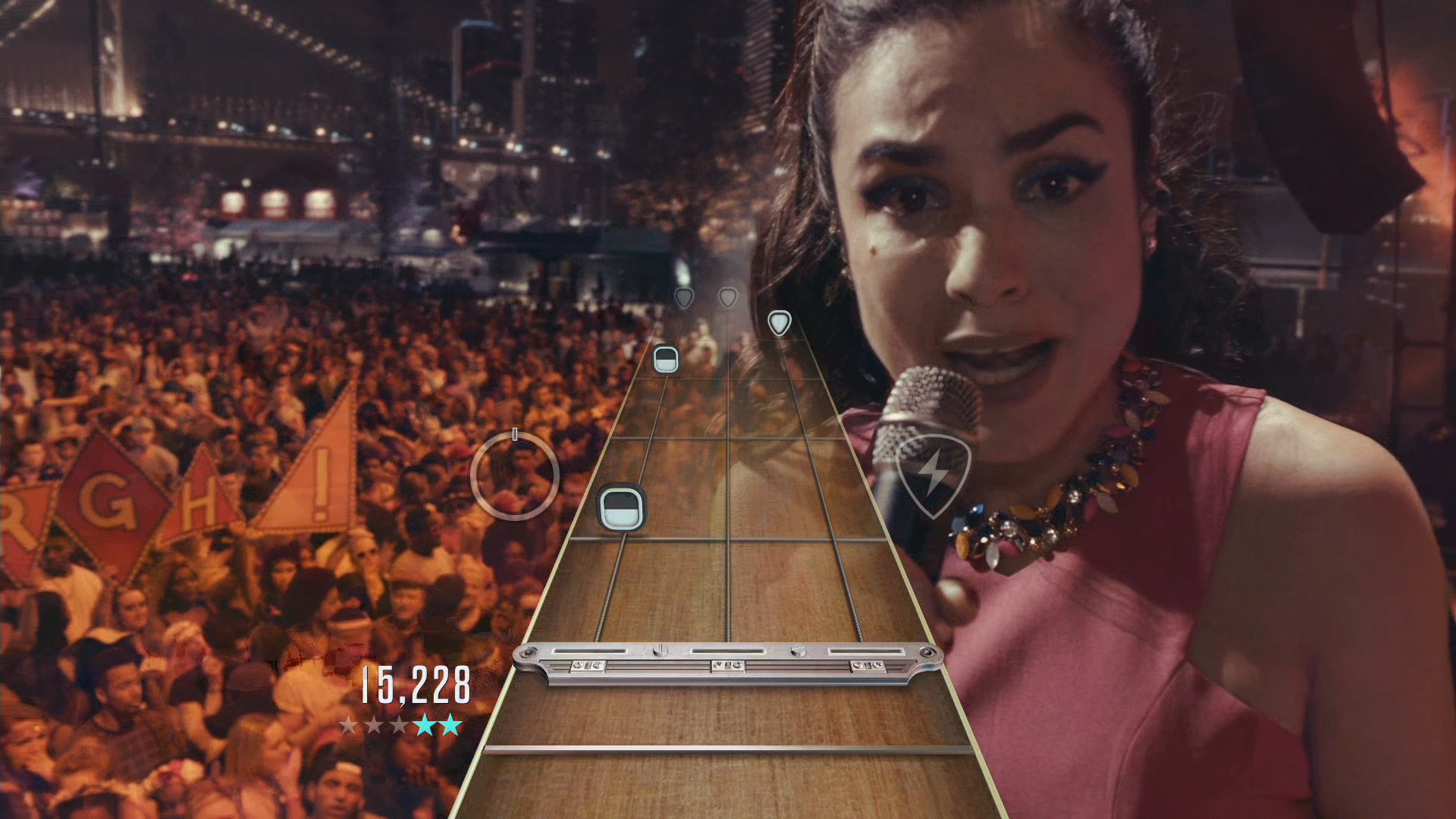 Yes, even despite these beautiful arseholes
Yes, even despite these beautiful arseholes
Despite the cheesy GH Live mode, the GHTV mode and its progression system offer compelling single-player content that can keep you engaged for hours.
The unique new guitar controller also makes Guitar Hero Live appealing to rhythm game fans seeking a fresh control system experience.
For solo players, Guitar Hero Live is arguably the more captivating experience.
However, if you prioritize social gaming and plan to host regular local multiplayer sessions with friends and family, Rock Band 4 is the better option.
 Rock Band 4 pic 2
Rock Band 4 pic 2
While lacking in single-player depth compared to Guitar Hero Live, Rock Band 4 excels in multiplayer entertainment. Furthermore, if you’ve invested in Rock Band DLC in the past, the ability to import much of it into Rock Band 4 is a significant advantage.
Price is also a factor. Guitar Hero Live with a guitar controller is often priced lower than Rock Band 4 with a guitar. However, Rock Band 4 offers the option to use older instruments, potentially reducing the cost if you already own compatible peripherals.
Ultimately, both Guitar Hero Live and Rock Band 4 are excellent rhythm games. The best choice depends on whether you’re a lone guitar hero or a social rocker.
